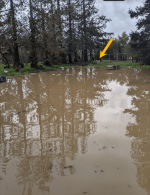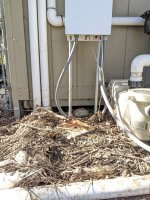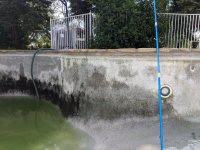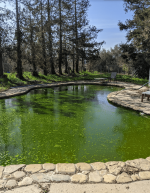In the recent California storms, we ended up with our entire pool and most of the equipment under flood waters. All that was visible was the diving board.
The water that's in it now is brown. I can't see the bottom, but I can feel the mud and I can stir it up by brushing (at least in the shallow end). I kept it chlorinated at first, but we've had a LOT going on with flood recovery in other areas of life and the pool took lower priority. Now there is a lovely layer of green slime on the top. I have been scooping it off with the net, adding gallons and gallons of chlorine, and it's a little better. I might try testing the water soon, but the water is so brown I'm not sure how well I will be able to detect color!
So, the big question now is....what next?
I have not run the pool pump other than for a couple of minutes to see if it would run at all after being under all that water. It did. But if my (separate/standalone) hot tub motor is any indication ( ) it might not run for more than 10 minutes and then grind horribly and have to be replaced.
) it might not run for more than 10 minutes and then grind horribly and have to be replaced.
I am concerned about running the pump because I can't see if the drain is covered in sludge or debris. What if it sucks up mud and crud that clogs the pipes? And then I have to tear up the yard or concrete looking for a clog in the line?
I have an external pump that can be used to pump the pool water into the creek, and so I have considered doing a simultaneous drain-and-fill until the water is clear enough to see how bad the mud is at the bottom. Don't want to drain it, because the water level is pretty high in the whole area right now, not like our usual drought conditions. The normally-dry creek hasn't even fully drained yet, and it's been 4 weeks since the last storm. The bottom of the creek is not much deeper than the pool, so.....not taking any chances.
I MIGHT be able to stir up the mud while the external pump is working and get some of it to vacate into the creek while doing a drain and fill. Not sure if it would be enough to make a difference.
And of course, there's the vacuum....but that would mean running the pool pump. See above.
There was a time when a pillowcase got sucked into the skimmer and pulled all the way into the filter basket at the equipment side. I was terrified it would ruin something, but I was able to just pull it right out. So the pipes from the skimmer to the equipment are big enough to handle that....but not sure about from the drain to the equipment.
Wondering if maybe it's better to wait until spring and let the ground dry out really good, then drain it and see what's under there?
Sooooo....any advice or suggestions are most welcome at this point!
The water that's in it now is brown. I can't see the bottom, but I can feel the mud and I can stir it up by brushing (at least in the shallow end). I kept it chlorinated at first, but we've had a LOT going on with flood recovery in other areas of life and the pool took lower priority. Now there is a lovely layer of green slime on the top. I have been scooping it off with the net, adding gallons and gallons of chlorine, and it's a little better. I might try testing the water soon, but the water is so brown I'm not sure how well I will be able to detect color!
So, the big question now is....what next?
I have not run the pool pump other than for a couple of minutes to see if it would run at all after being under all that water. It did. But if my (separate/standalone) hot tub motor is any indication (
I am concerned about running the pump because I can't see if the drain is covered in sludge or debris. What if it sucks up mud and crud that clogs the pipes? And then I have to tear up the yard or concrete looking for a clog in the line?
I have an external pump that can be used to pump the pool water into the creek, and so I have considered doing a simultaneous drain-and-fill until the water is clear enough to see how bad the mud is at the bottom. Don't want to drain it, because the water level is pretty high in the whole area right now, not like our usual drought conditions. The normally-dry creek hasn't even fully drained yet, and it's been 4 weeks since the last storm. The bottom of the creek is not much deeper than the pool, so.....not taking any chances.
I MIGHT be able to stir up the mud while the external pump is working and get some of it to vacate into the creek while doing a drain and fill. Not sure if it would be enough to make a difference.
And of course, there's the vacuum....but that would mean running the pool pump. See above.
There was a time when a pillowcase got sucked into the skimmer and pulled all the way into the filter basket at the equipment side. I was terrified it would ruin something, but I was able to just pull it right out. So the pipes from the skimmer to the equipment are big enough to handle that....but not sure about from the drain to the equipment.
Wondering if maybe it's better to wait until spring and let the ground dry out really good, then drain it and see what's under there?
Sooooo....any advice or suggestions are most welcome at this point!
Last edited:






